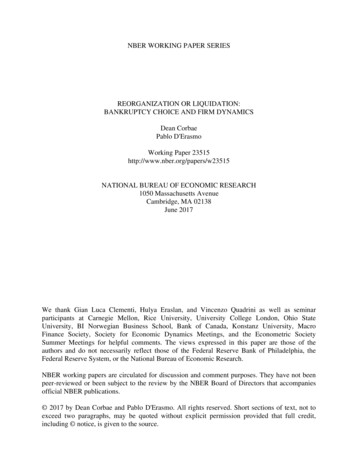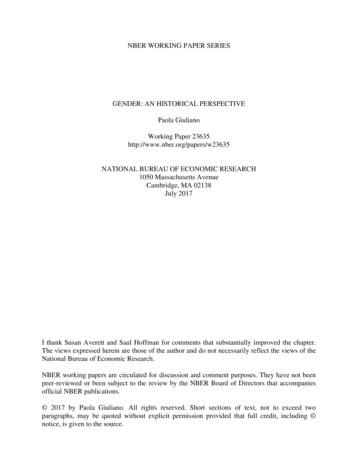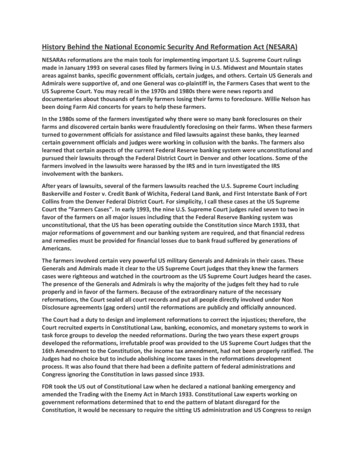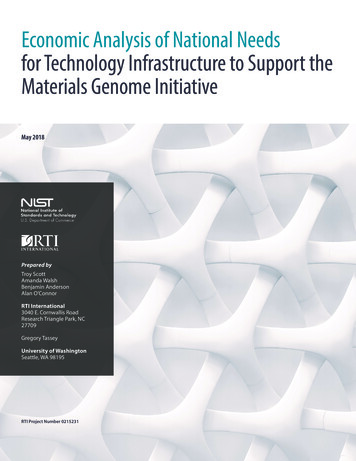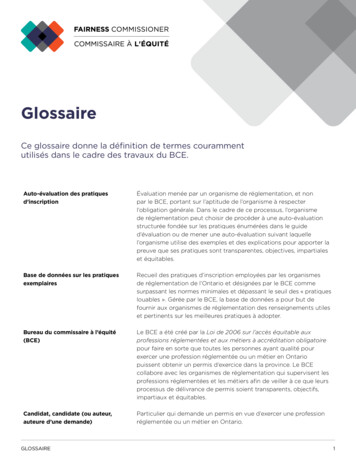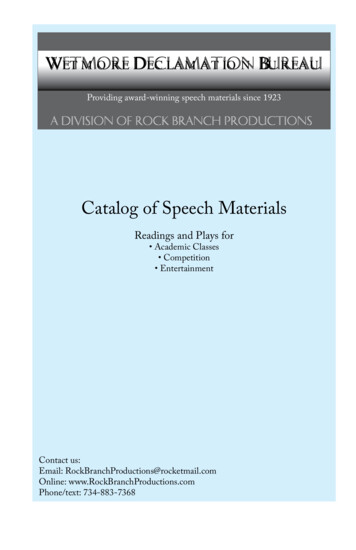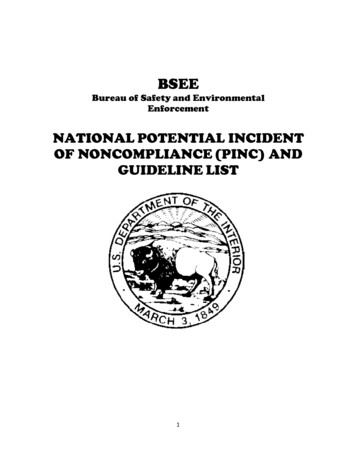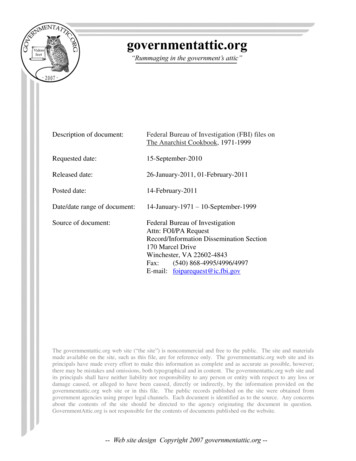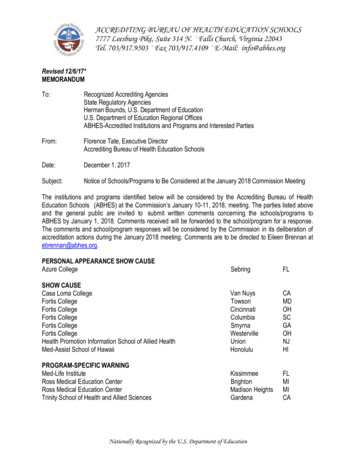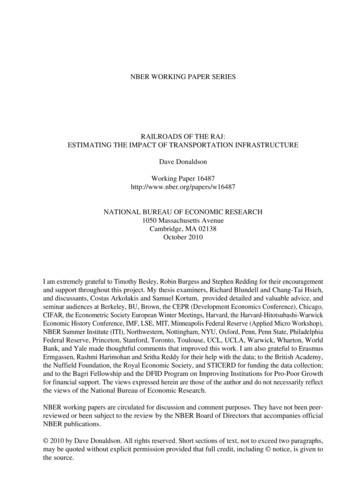
Transcription
NBER WORKING PAPER SERIESRAILROADS OF THE RAJ:ESTIMATING THE IMPACT OF TRANSPORTATION INFRASTRUCTUREDave DonaldsonWorking Paper 16487http://www.nber.org/papers/w16487NATIONAL BUREAU OF ECONOMIC RESEARCH1050 Massachusetts AvenueCambridge, MA 02138October 2010I am extremely grateful to Timothy Besley, Robin Burgess and Stephen Redding for their encouragementand support throughout this project. My thesis examiners, Richard Blundell and Chang-Tai Hsieh,and discussants, Costas Arkolakis and Samuel Kortum, provided detailed and valuable advice, andseminar audiences at Berkeley, BU, Brown, the CEPR (Development Economics Conference), Chicago,CIFAR, the Econometric Society European Winter Meetings, Harvard, the Harvard-Hitotsubashi-WarwickEconomic History Conference, IMF, LSE, MIT, Minneapolis Federal Reserve (Applied Micro Workshop),NBER Summer Institute (ITI), Northwestern, Nottingham, NYU, Oxford, Penn, Penn State, PhiladelphiaFederal Reserve, Princeton, Stanford, Toronto, Toulouse, UCL, UCLA, Warwick, Wharton, WorldBank, and Yale made thoughtful comments that improved this work. I am also grateful to ErasmusErmgassen, Rashmi Harimohan and Sritha Reddy for their help with the data; to the British Academy,the Nuffield Foundation, the Royal Economic Society, and STICERD for funding the data collection;and to the Bagri Fellowship and the DFID Program on Improving Institutions for Pro-Poor Growthfor financial support. The views expressed herein are those of the author and do not necessarily reflectthe views of the National Bureau of Economic Research.NBER working papers are circulated for discussion and comment purposes. They have not been peerreviewed or been subject to the review by the NBER Board of Directors that accompanies officialNBER publications. 2010 by Dave Donaldson. All rights reserved. Short sections of text, not to exceed two paragraphs,may be quoted without explicit permission provided that full credit, including notice, is given tothe source.
Railroads of the Raj: Estimating the Impact of Transportation InfrastructureDave DonaldsonNBER Working Paper No. 16487October 2010JEL No. F15,N15,N75,O1,R13,R4ABSTRACTHow large are the benefits of transportation infrastructure projects, and what explains these benefits?To shed new light on these questions, this paper uses archival data from colonial India to investigatethe impact of India's vast railroad network. Guided by four predictions from a general equilibriumtrade model, I find that railroads: (1) decreased trade costs and interregional price gaps; (2) increasedinterregional and international trade; (3) increased real income levels; and (4), that a sufficient statisticfor the effect of railroads on welfare in the model (an effect that is purely due to newly exploited gainsfrom trade) accounts for virtually all of the observed reduced-form impact of railroads on real incomein the data. I find no spurious effects from over 40,000 km of lines that were approved but - for fourdifferent reasons - were never built.Dave DonaldsonMIT Department of Economics50 Memorial Drive, E52-243GCambridge, MA 02142-1347and NBERddonald@mit.edu
1IntroductionIn 2007, almost twenty percent of World Bank lending was allocated to transportation infrastructure projects, a larger share than that of education, health and social services combined(World Bank, 2007). These projects aim to reduce the costs of trading. In prominent modelsof international and interregional trade, reductions in trade costs will increase the level of realincome in trading regions. Unfortunately, despite an emphasis on reducing trade costs in botheconomic theory and contemporary aid efforts, we lack a rigorous empirical understanding ofthe extent to which transportation infrastructure projects actually reduce the costs of trading,and how the resulting trade cost reductions affect welfare.In this paper I exploit one of history’s great transportation infrastructure projects—thevast network of railroads built in colonial India (India, Pakistan and Bangladesh; henceforth,simply ‘India’)—to make three contributions to our understanding of transportation infrastructure improvements. In doing so I draw on a comprehensive new dataset on the colonialIndian economy that I have constructed. First, I estimate the extent to which railroads improved India’s trading environment (ie, reduced trade costs, reduced interregional price gaps,and increased trade flows). Second, I estimate the reduced-form welfare gains (higher realincome levels) that the railroads brought about. Finally, I assess, in the context of a generalequilibrium trade model, how much of these reduced-form welfare gains could be plausiblyinterpreted as newly exploited gains from trade.The railroad network designed and built by the British government in India (then known tomany as ‘the Raj’) brought dramatic change to the technology of trading on the subcontinent.Prior to the railroad age, bullocks carried most of India’s commodity trade on their backs,traveling no more than 30 km per day along India’s sparse network of dirt roads (Deloche,1994). By contrast, railroads could transport these same commodities 600 km in a day, and atmuch lower per unit distance freight rates. As the 67,247 km long railroad network expandedfrom 1853 to 1930, it penetrated inland districts (local administrative regions), bringing themout of near-autarky and connecting them with the rest of India and the world. I use thearrival of the railroad network in each district to investigate the economic impact of thisstriking improvement in transportation infrastructure.This setting is unique because the British government collected detailed records of economic activity throughout India in this time period—remarkably, however, these records havenever been systematically digitized and organized by researchers. I use these records to construct a new, district-level dataset on prices, output, daily rainfall and interregional andinternational trade in India, as well as a digital map of India’s railroad network in which each20 km segment is coded with its year of opening. This dataset allows me to track the evolutionof India’s district economies before, during, and after the expansion of the railroad network.1
The availability of records on interregional trade is particularly unique and important here.Information on trade flows within a country is rarely available to researchers, yet the responseof these trade flows to a transportation infrastructure improvement says a great deal aboutthe potential for gains from trade (as I describe explicitly below).To guide my empirical analysis I develop a Ricardian trade model with many regions,many commodities, and where trade occurs at a cost. Because of geographical heterogeneity,regions have differing productivity levels across commodities, which creates incentives to tradein order to exploit comparative advantage. A new railroad link between two districts lowerstheir bilateral trade cost, allowing consumers to buy goods from the cheapest district, andproducers to sell more of what they are best at producing. There are thousands of interactingproduct and factor markets in the model. But the analysis of this complex general equilibriumproblem is tractable if production heterogeneity takes a convenient but plausible functionalform, as shown by Eaton and Kortum (2002).I use this model to assess empirically the importance of one particular mechanism linkingrailroads to welfare improvements—that railroads reduced trade costs and thereby allowedregions to gain from trade. The model makes four predictions that drive my four-step empiricalanalysis:1. Inter-district price differences are equal to trade costs (in special cases): That is, if acommodity can be made in only one district (the ‘origin’) but is consumed in otherdistricts, then that commodity’s origin-destination price difference is equal to its origindestination trade cost. Empirically, I use this result to measure trade costs (which, likeall researchers, I cannot observe directly) by exploiting widely-traded commodities thatcould only be made in one district. Using inter-district price differentials, along with agraph theory algorithm embedded in a non-linear least squares routine, I estimate thetrade cost parameters governing traders’ endogenous route decisions on a network ofroads, rivers, coasts and railroads. This is a novel method for inferring trade costs innetworked settings. My resulting parameter estimates reveal that railroads significantlyreduced the cost of trading in India.2. Bilateral trade flows take the ‘gravity equation’ form: That is, holding constant exporterand importer-specific effects, bilateral trade costs reduce bilateral trade flows. Empirically, I use the estimate from a gravity equation, in conjunction with the trade costparameters estimated in Step 1, to identify all of the relevant unknown parameters ofthe model.3. Railroads increase real income levels: That is, when a district is connected to the railroadnetwork its real income rises. Empirically, I find that railroad access raises real income2
by 16 percent. This reduced-form estimate could arise through a number of economicmechanisms. A key goal of Step 4 below is to assess how much of the reduced-formimpact of railroads on real income can be attributed to gains from trade due to thetrade cost reductions found in Step 1.4. There exists a sufficient statistic for the welfare gains from railroads: That is, despite thecomplexity of the model’s general equilibrium relationships, the impact of the railroadnetwork on welfare in a district is captured by its impact on one endogenous variable:the share of that district’s expenditure that it sources from itself. A prediction similar tothis appears in a wide range of trade models but has not, to my knowledge, been testedbefore.1 Empirically, I test this prediction by regressing real income on this sufficientstatistic (as calculated using the model’s parameter estimates obtained in Steps 1 and2) alongside the regressors from Step 3 (which capture the reduced-form impact ofrailroads). When I do this, the estimated reduced-form coefficients on railroad access(from Step 3) fall to a level that is close to zero. This finding provides support forPrediction 4 of the model and implies that decreased trade costs account for virtuallyall of the real income impacts of the Indian railroad network.These four results demonstrate that India’s railroad network improved the trading environment (Steps 1 and 2) and generated welfare gains (Steps 3), and suggest that these welfaregains arose predominantly because railroads allowed regions to exploit gains from trade (Step4).A natural concern when estimating the impact of infrastructure projects is that of biasdue to a potential correlation between project placement and unobserved changes in the localeconomic environment. These concerns are likely to be less important in my setting because(as described in Section 2) military motives for railroad placement usually trumped economicarguments, the networked nature of railroad technology inhibited the ability of planners totarget specific locations precisely, and planning documents reveal just how hard it was fortechnocrats to agree on the efficacy of railroad plans. Nevertheless, to mitigate concerns ofselection bias I estimate the ‘effects’ of over 40,000 km of railroad lines that reached advancedstages of costly surveying but—for four separate reasons that I document in Section 6—werenever actually built. Reassuringly, these ‘placebo’ lines never display spurious effects.This paper contributes to a growing literature on estimating the economic effects of largeinfrastructure projects,2 as well as to a literature on estimating the ‘social savings’ of rail1Arkolakis, Costinot, and Rodriguez-Clare (2010) show that this prediction applies to the Krugman (1980),Eaton and Kortum (2002), and Chaney (2008) models of trade, but these authors do not test this predictionempirically.2For example, Dinkelman (2007) estimates the effect of electrification on labor force participation in South3
road projects.3 A distinguishing feature of my approach is that, in addition to estimatingreduced-form relationships between infrastructure and welfare, as in the existing literature, Ifully specify and estimate a general equilibrium model of how railroads affect welfare.4 Themodel makes auxiliary predictions and suggests a sufficient statistic for the role played byrailroads in raising welfare—all of which shed light on the economic mechanisms that couldexplain my reduced-form estimates. Using a model also improves the external validity of myestimates because the primitive in my model—the cost of trading—is specified explicitly, andis portable to a range of settings (such as tariff liberalization or road construction) in which thewelfare benefits of trade cost-reducing polices might be sought. By contrast, my reduced-formestimates are more likely to be specific to the context of railroads in colonial India.This paper also contributes to a rich literature concerned with estimating the welfareeffects of openness to trade, because the reduction in trade costs brought about by India’srailroad network rapidly increased each district’s opportunities to trade.5 Again, the fact thatmy empirical approach connects explicitly to an estimable, general equilibrium model of tradeoffers advantages over the existing literature. The model suggests a theoretically-consistentway to measure ‘openness,’ sheds light on why trade openness raises welfare, and provides anatural way to study changes in openness to both internal and external trade at the sametime.The next section describes the historical setting in which the Indian railroad network wasconstructed and the new data that I have collected from that setting. In Section 3, I outline amodel of trade in colonial India and the model’s four predictions. Sections 4 through 7 presentfour empiri
trade cost parameters governing traders’ endogenous route decisions on a network of roads, rivers, coasts and railroads. This is a novel method for inferring trade costs in networked settings. My resulting parameter estimates reveal that railroads signi cantly reduced the cost of trading
